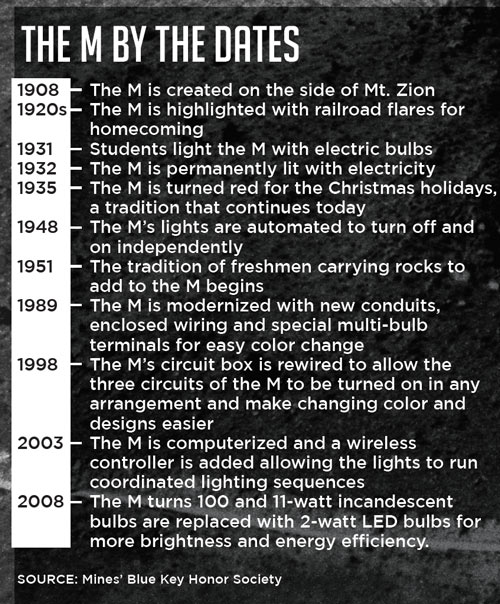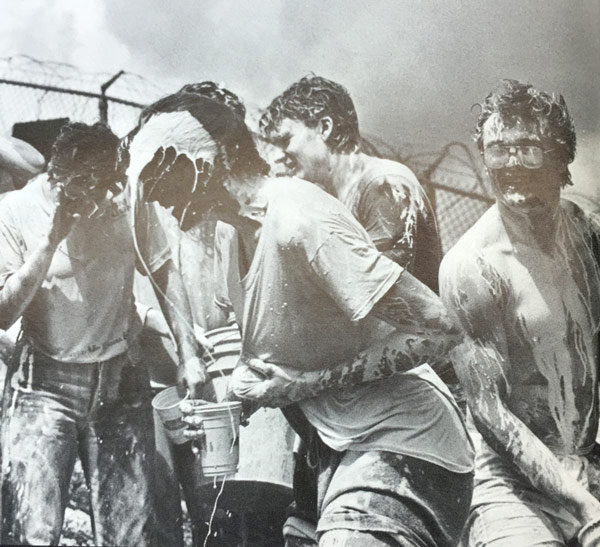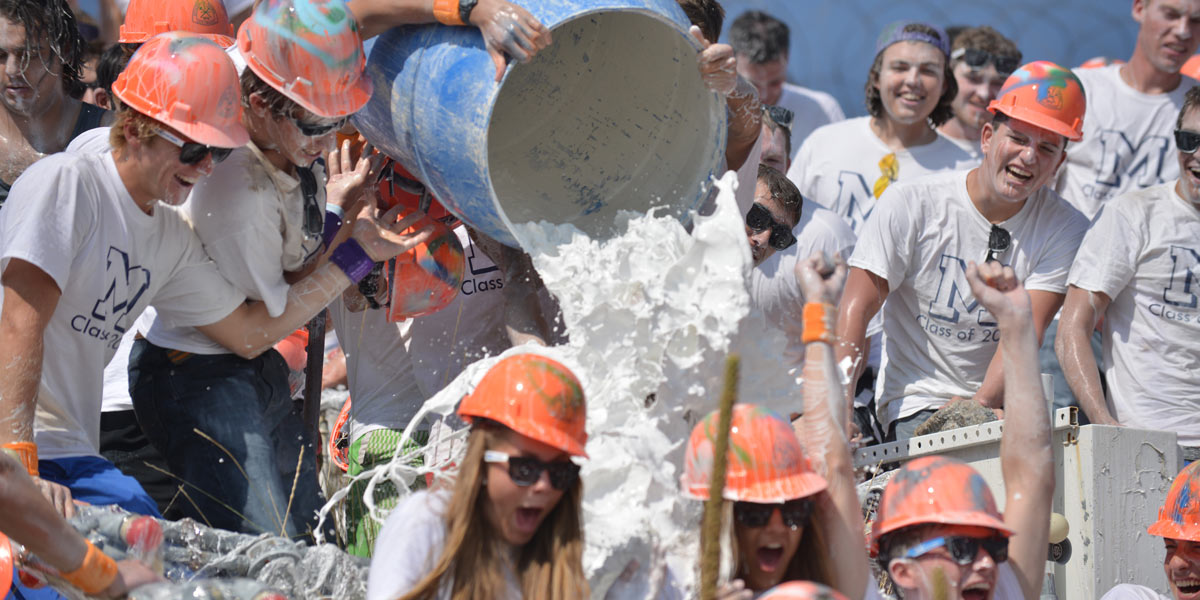The Famous ‘M’ Brings Mines Students Together
Ed May ’65 had some unfinished business at Colorado School of Mines. It was a half century since he graduated, and something still nagged at him all these years later: not making the traditional climb to the M on Mt. Zion.
Just before his freshman class’ M Climb back in 1961, May sprained an ankle while rock climbing in Clear Creek Canyon and couldn’t make it up the mountain. So last fall, May made amends.
“I was writing up my life story for my family, and I realized I had a few loose ends,” May says. “One of the loose ends was that there was no Ed May rock on the M. It makes sense that a 77-year-old alumnus wouldn’t want such a blaring omission in his life—the M and the climb to it are entrenched in a rich history.
 It’s believed the M was born in 1908. The Golden Globe, the city’s newspaper at the time, reported that about 20 faculty members and 250 seniors from the class of 1908 — inspired by the U at the University of Utah and driven by a fellow student Herbert Everest’s descriptive geometry problem of designing the M for his senior thesis—placed the 104 feet by 107 feet M on Mt. Zion on May 15, 1908, resting on a 23-degree slope.
It’s believed the M was born in 1908. The Golden Globe, the city’s newspaper at the time, reported that about 20 faculty members and 250 seniors from the class of 1908 — inspired by the U at the University of Utah and driven by a fellow student Herbert Everest’s descriptive geometry problem of designing the M for his senior thesis—placed the 104 feet by 107 feet M on Mt. Zion on May 15, 1908, resting on a 23-degree slope.
Now, Mines’ Blue Key Honor Society is charged with care for the M and the traditions surrounding it. Michelle Kozel, the program assistant for environmental health and safety and the society’s faculty advisor, says most of the changes to the M over the decades have been related to making it more visible.
“Blue Key members did a lot of research for the M’s 100th anniversary in 2008 and learned that students have been whitewashing the rocks of the M from the beginning,” Kozel says.
But Mines wanted to do more than fill the M with white rocks. In the 1920s, students used railroad flares to highlight the M during homecoming. Then for homecoming in 1931, Blue Key members used a tractor to haul a generator, some poles, wire and bulbs up Mt. Zion to light the M. That went over so well, Blue Key started a fundraising campaign, hitting up alumni and Golden businesses for cash to light it permanently. In one year, they raised enough money to cover the cost, and in March 1932, the M began glowing at night with 25-watt bulbs.
In 1989, Blue Key modernized the lighting with upgraded wire and replaced the light sockets with weatherproof 11-watt bulbs. About nine years later, the M’s circuit box was rewired so lights could be lit in varying arrangements, designs and colors.
The first renovations in the 21st century included computerized lighting with a wireless controller in 2003 that allowed for remote operation from the Mines campus. And in 2008, for the M’s 100th anniversary, Blue Key replaced the incandescent lights with energy-efficient, two-watt LED bulbs.
 Despite the technological additions to make the M more visible, carrying a rock up the mountain is still an important tradition at Mines. Kozel says freshmen began carrying rocks to add to the M in 1951. “That’s when it was made part of freshman orientation as a way of unifying the freshman class and instilling them with school spirit,” she says.
Despite the technological additions to make the M more visible, carrying a rock up the mountain is still an important tradition at Mines. Kozel says freshmen began carrying rocks to add to the M in 1951. “That’s when it was made part of freshman orientation as a way of unifying the freshman class and instilling them with school spirit,” she says.
In a phrase, the tradition became the climb that binds all Mines students and alumni. That was one of the first lessons Mines President Paul C. Johnson learned when he arrived in 2015.
“I’d never seen anything quite like it,” Johnson says, and has vowed to make the climb every fall. “It’s their first big event as a community—a symbol of the start of their journey, and they know others have made the same journey. It’s a neat and memorable tradition, and students can always share that experience with others who went to Mines. They all did the same climb and carried their rocks.”
Fifty years after he was supposed to participate in the tradition, May admits he had some reservations about being able to make the climb, but says a few steps into the ascent, he knew he’d make it to the famed M. “I was literally swept up the hill by the enthusiasm of young, eager freshmen,” May says. “The best part of it all was meeting the students. I was proud to be included in such a dynamic crowd of future engineers and business leaders.”
May then adds this about the climb: “No matter what the obstacle, if you have the motivation, all things are possible. So my story of the climb is that once motivated, you can accomplish much in life—whether you’re a young student embarking on life or an old curmudgeon lugging a rock up a mountain.”
Reprinted from the fall 2016 issue of Mines Magazine, the Colorado School of Mines Alumni Magazine
Story by Doug McPherson




